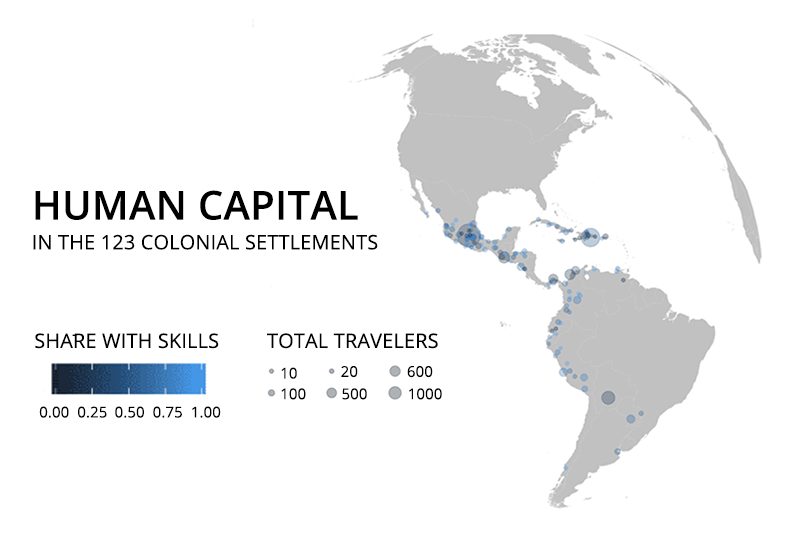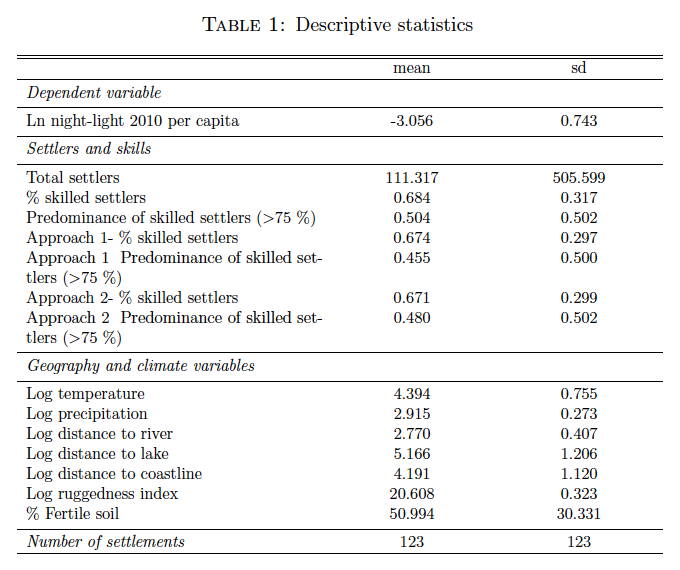Original photo: De Deensel – Las Condes
There has been a long-standing interest in colonialism and its persistent impact on the long-run development of colonized countries. One of the challenges of studying this topic is to disentangle the role of differences in the colonizer – that is, its institutional and legal features – from the influence of the culture and human capital of the colonies.
In BSE Working Paper No. 1189, “Colonization, Early Settlers and Development: The Case of Latin America,” José G. Montalvo and Marta Reynal-Querol explore the historical roots of economic development for the case of Latin America. Specifically, the authors compile and make use of novel data on the first settlers in the Americas sent to the Spanish colonies between 1492 and 1540. The period under analysis constitutes a natural experiment to explore the causal relationship between colonizers’ skills and colonies’ economic development. Findings reveal that areas in Latin America that received the highest proportions of skilled settlers today have greater income per capita than places that received large numbers of unskilled settlers.
The early Spanish colonizers of Latin America
The paper’s first contribution is to divulge novel information about the early Spanish colonizers of Latin America. The authors compile detailed data on the first 22,000 settlers across 123 settlement-locations between 1942 and 1540 including their name, city of origin, destination, occupation, movements within the Americas, and year and place of death. This was possible thanks both to the fact that there was just one legal port of departure in Spain (Seville), and to the existence of restrictions for embarkation to the Americas which was recorded in administrative written documents available until today.
Figure 1 depicts the locations of all the settlements identified for the covered period, where the size of the bubbles reflects the number of settlers in the final year of 1540. The relation between location and number of settlers looks arbitrarily and heterogenous.

To retrieve a skill measure from occupational data, the authors consider as having a relatively high level of human capital those individuals with occupations requiring skills such being able to read and write, or necessitating entrepreneurial drive. For example, the skilled settlers include doctors, lawyers, pharmacists, while unskilled are essentially peasants and servants. Figure 2 depicts each of the destinations according to the proportion of settlers who were skilled. The colors of the dots on the map show a clear heterogeneity across locations in terms of the first settlers’ skills levels. Importantly, the geographical distribution of skills seems random.

Empirical strategy and results
The key insight in the paper is to acknowledge the natural experiment feature of the historical period studied. First and as shown above, the settling across the New World was as good as random since the initial colonizers had no knowledge of the new land. This coupled with the single colonial power, which enables to disentangle the role of differences in institutional set up or legal origin from the influence of colonies’ offers a unique and new methodology to analyse the long-run effect of skill heterogeneity in the Spanish colonization of the Americas.
Table 1 summarizes the descriptive statistics of the data, including controls variables regarding geography and climate.

The main empirical specification looks at the direct effect of the proportion of skilled settlers among the early Spanish colonizers in today’s levels of development around the original locations. Table 2 presents the results of this relationship. It shows that the locations that received a higher percentage of skilled early settlers are more developed today than those that received a low proportion of skilled individuals. The estimation is statistically and economically significant: areas that received only high-skilled settlers have a 60% higher level of GDP per capita than do areas that received only low skilled settlers. This result is basically unaffected if controls for geography, climate and land characteristics (see the paper for more details).

In addition to a thoroughly robust analysis, which supports the above findings, the authors also investigate possible mechanisms behind the long-run effect of early-settlers skills on colonized areas’ development. They provide evidence that such persistence is driven by a form of market orientation and entrepreneurial spirit. Areas that had a higher proportion of skilled first settlers have more positive attitudes towards the role of entrepreneurship in development, use more land for crops and have a greater density of roads, than do areas that had lower levels of skilled early colonizers. Therefore, results suggest that the level of entrepreneurship, agriculture activities and transportation infrastructures are important channels that sustain the positive effect of colonizers’ skills on Latin America development.



